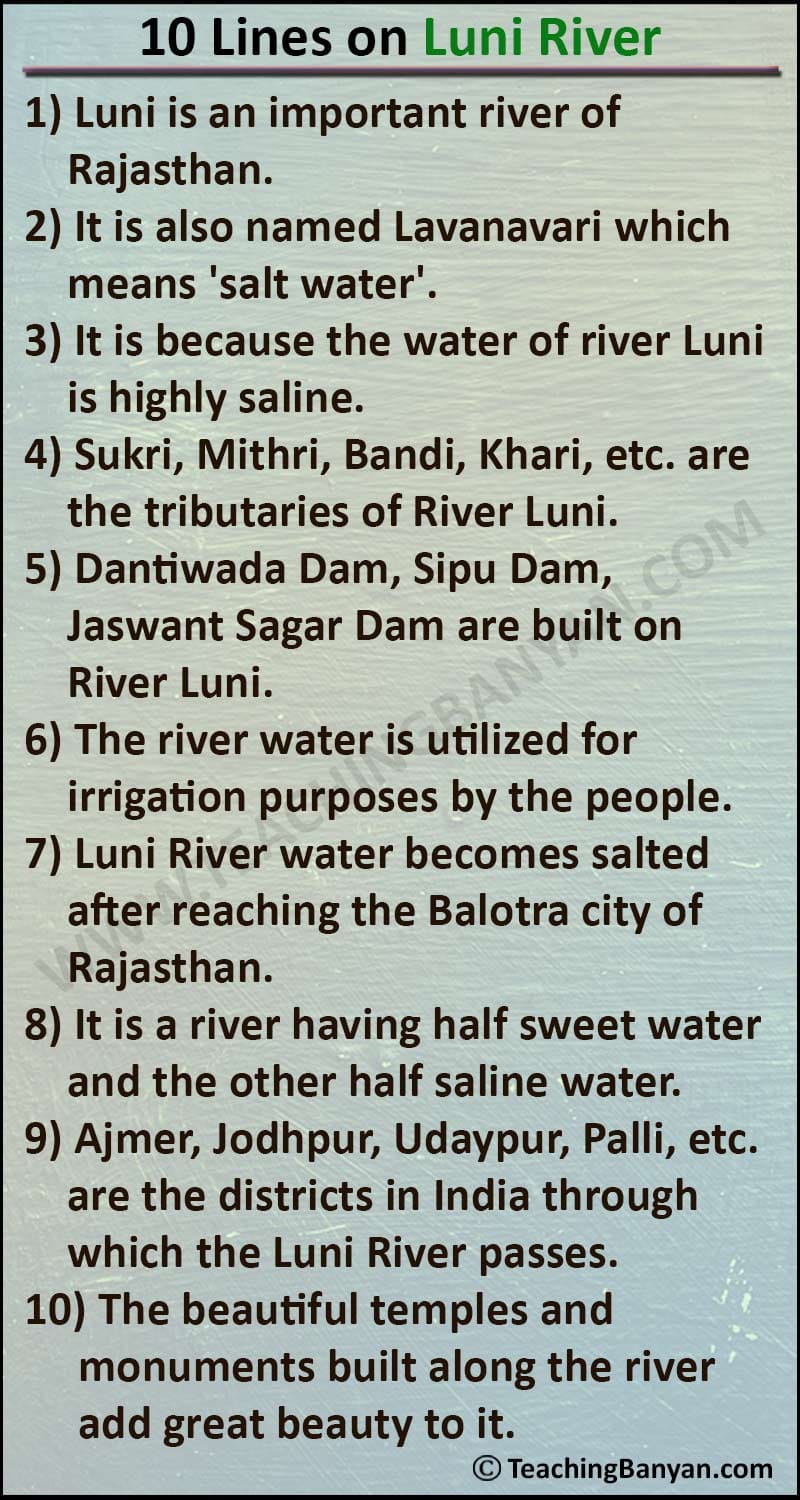Luni River is one of the major rivers which flow into Rajasthan and Gujarat. It originates from the Aravalli hills near Ajmer district and then it flows through the districts of Rajasthan. It finally falls into Rann of Kutch in Gujarat. Luni River is a saline river due to its flow through salt rich surfaces because it absorbs the high salt content of the soil making the river to turn salty.
When Luni River enters Ajmer, it is called Sagarmati. It is a very much useful and important river for irrigation as well as transportation purposes. Luni River is also known Lavanaravi or Lavanavati which means “Salt River” in Sanskrit due to the high salinity of its water.
Ten Lines on Luni River in English
10 Lines on Luni River
1) Luni is one of the major rivers which flows in the western part of India i.e. Rajasthan.
2) It is an inter-state river that flows through the states of Rajasthan and Gujarat.
3) Luni River originates from Aravalli range near Ajmer district of Rajasthan.
4) After entering Ajmer district of Rajasthan, Luni River is known as Sagarmati.
5) After origin, Luni River takes north-western direction and flows into Nagaur district.
6) The river passes through Thar Desert and finally falls into Ran of Kutch in Gujarat.
7) The length of Luni River is 495 km with the coverage area of 37,363 sq. km.
8) Luni River is a seasonal river that receives its water from south-east of Aravalli range.
9) The major tributaries of Luni River are Jowai, Sukri and Jojari rivers.
10) Cities located on the banks of Luni River are Ajmer, Jodhpur, Patan, Banas Kantha etc.
10 Lines and Sentences on Luni River
1) Luni River emerges from western India.
2) It is regarded as the largest river in the Thar Desert of India.
3) Luni River is rain fed and thus a seasonal river.
4) It traces its course through the Rajasthan and Gujarat states of India.
5) Pushkar valley near Ajmer in Rajasthan is the originating place of the Luni River.
6) The river rises from a height of 550m and is called Sagarmati.
7) The confluence of Sagarmati and its tributary Saraswati forms river Luni.
8) Luni River is 495 km in length.
9) The area of the drainage basin of river Luni is 37363 square km.
10) Luni River terminates into marshy lands of Rann of Kutch in Gujarat.

5 Lines on Luni River
1) It is also known as Lavanavari.
2) It is highly saline.
3) It arises from Rajasthan.
4) It provides water for irrigation.
5) Its tributaries are Khari, Bandi, Mithri, Sukri, etc.
20 Lines on Luni River
1) Luni is an important river of Rajasthan.
2) It is also named Lavanavari which means ‘salt water’.
3) It is because the water of river Luni is highly saline.
4) Sukri, Mithri, Bandi, Khari, etc are the tributaries of River Luni.
5) Dantiwada Dam, Sipu Dam, Jaswant Sagar Dam are built on River Luni.
6) The river water is utilized for irrigation purposes by the people.
7) Luni River water becomes salted after reaching the Balotra city of Rajasthan.
8) It is a river having half sweet water and the other half saline water.
9) Ajmer, Jodhpur, Udaypur, Palli, etc. are the districts in India through which the Luni River passes.
10) The beautiful temples and monuments built along the river add great beauty to it.
11) Luni River is a perennial and inter-state river that starts flowing towards the west starting from Rajasthan and flows through Gujarat.
12) In Sanskrit, Luni River is also known as ‘Lavanaravi’ or ‘Lavanavati’ which means “salt river” due to high salinity in the water of Luni River.
13) The river originates from Pushkar valley located in the western slopes of the Aravalli mountain ranges near Ajmer where it is known as Sagarmati.
14) At Govindgarh, Luni River meets Sarsuti, its tributary and then it travels to the north-western direction of Nagaur and continue after taking south west direction.
15) After taking south-west direction from Nagaur, Luni River arrives at Pali near Aravalli hills and reaches in the plains of Marwar region of Jodhpur.
16) Luni River continues in the same direction into Barmer and Jalore and finally enters into the Rann of Kutch, Gujarat, where it forms a delta and spreads the water.
17) The Luni Basin is surrounded by Aravalli range and Gujarat plains in the east, Rajasthan desert in the north and the Arabian Sea in the south as well as in the west.
18) The major tributary in the left bank of Luni River is Jojri and the tributaries which are flowing in the right direction are Jawai, Khari, Sukri, Bandi, Saagi etc.
19) With the course of 540 km, Luni River is the only major river in the area which is very useful and important for agriculture and irrigation of food crops.
20) In 1892, Maharaja Jaswant Singh constructed a dam at Pichiyak village in Jodhpur district to use the river water.
The water of Luni River is suitable for irrigation and transportation purposes and hence many dams have been constructed over the river. In 1892, Maharaja Jaswant Singh constructed a dam at Pichiyak, located in Jodhpur on Luni River. The Dantiwda Dam and Sipu Dam are also constructed on Luni River which are helpful for irrigation of the nearby areas which come under the Aravalli range and Marwar region of Jodhpur.
